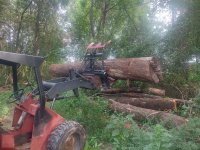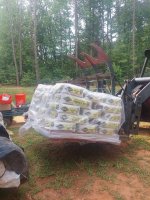Porkchop Express
New member
Hi Power Trac forum members. I've been reading many of the threads here recently and was hoping to get a few questions answered about the PT1460 model. We live on a 60 acre plot of land and we also have a small sawmill operation. We have an old Deere 482C rough terrain forklift that has an unknown thousands of hours on it. It's a workhorse that does all the heavy lifting around here, especially at our sawmill, but it's also getting old and we don't have anything else that can share the load in the event that it needs any big repairs, which it eventually will. I'm thinking in the next year or so that I will probably buy something like a 50-60 HP sized tractor to use as a backup for the forklift and also to do many of the chores that my Kubota BX2380 does for us. We use that one for grass cutting as well as every manner of daily odd tasks, much the same as most forum members use their PT425s. In fact, we have put about 200 hours a year on the BX for the past 4 years, and a lot of that is doing things that could definitely be done a lot faster with a bigger, more capable tractor or possibly a large Power Trac.
I've looked at the Power Trac website and I think most people would agree that the info there is a bit limited and inconsistent. Could anyone tell me exactly how tall the 1460 model is? From the pictures it looks like it would probably fit into my garage, much the same as my BX does now with the ROPS up. Also, when they say it will lift 2400 pounds, I'm assuming they mean to full lift height at the pivot pins? Do you 1460 owners find that the 2400 pound lift capacity is true? Obviously putting something way out on forks will severely limit the amount that can be lifted, but let's say if you have a 2000 pound log sitting right up against the back of the forks, does the 1460 likely have enough weight/muscle to lift it to full height on level ground without mayhem? Also, the size tractor I'd probably consider is something like a Kubota MX5400, which is listed about 9 inches wider, but definitely would have a higher center of gravity. I'm guessing the 1460 although being a bit more narrow would still probably be a more stable platform for doing heavy lifting? And what is everyone's opinion on the Deutz diesels? Just as good/reliable as a Kubota engine?
I really like the idea of articulated loaders. I'm sneaking up on 50 soon and I've officially hit that point in life where I really don't like dealing with PTOs much and I also don't like constantly looking back over my shoulder at whatever implement I have hooked up behind me. Having a machine where all the implements or attachments can be used out front and easily hooked up is really appealing. As far as I can tell the price of a new 1460 is roughly the same as a similar lift capacity on a tractor, so I'm just trying to get an idea of how something like the 1460 does in the real world. We don't really do any stuff here that would require the pulling power of a big tractor. Instead, we do a ton of loader work (bucket, forks, grapple stuff) along with a fair amount of brush cutting. So an articulated loader might be a good fit.
I've looked at the Power Trac website and I think most people would agree that the info there is a bit limited and inconsistent. Could anyone tell me exactly how tall the 1460 model is? From the pictures it looks like it would probably fit into my garage, much the same as my BX does now with the ROPS up. Also, when they say it will lift 2400 pounds, I'm assuming they mean to full lift height at the pivot pins? Do you 1460 owners find that the 2400 pound lift capacity is true? Obviously putting something way out on forks will severely limit the amount that can be lifted, but let's say if you have a 2000 pound log sitting right up against the back of the forks, does the 1460 likely have enough weight/muscle to lift it to full height on level ground without mayhem? Also, the size tractor I'd probably consider is something like a Kubota MX5400, which is listed about 9 inches wider, but definitely would have a higher center of gravity. I'm guessing the 1460 although being a bit more narrow would still probably be a more stable platform for doing heavy lifting? And what is everyone's opinion on the Deutz diesels? Just as good/reliable as a Kubota engine?
I really like the idea of articulated loaders. I'm sneaking up on 50 soon and I've officially hit that point in life where I really don't like dealing with PTOs much and I also don't like constantly looking back over my shoulder at whatever implement I have hooked up behind me. Having a machine where all the implements or attachments can be used out front and easily hooked up is really appealing. As far as I can tell the price of a new 1460 is roughly the same as a similar lift capacity on a tractor, so I'm just trying to get an idea of how something like the 1460 does in the real world. We don't really do any stuff here that would require the pulling power of a big tractor. Instead, we do a ton of loader work (bucket, forks, grapple stuff) along with a fair amount of brush cutting. So an articulated loader might be a good fit.


